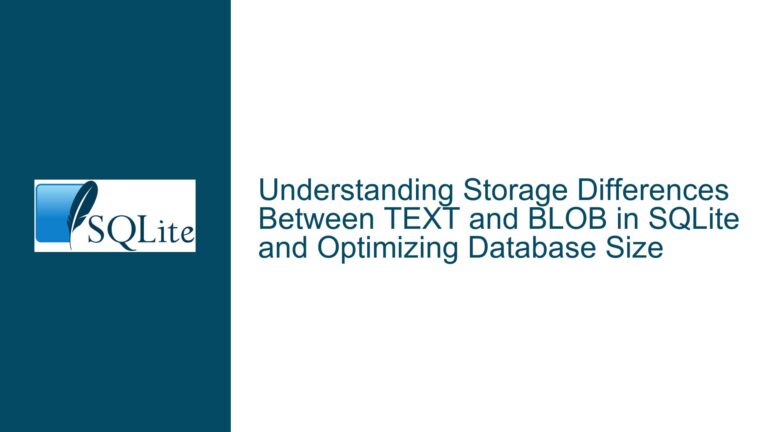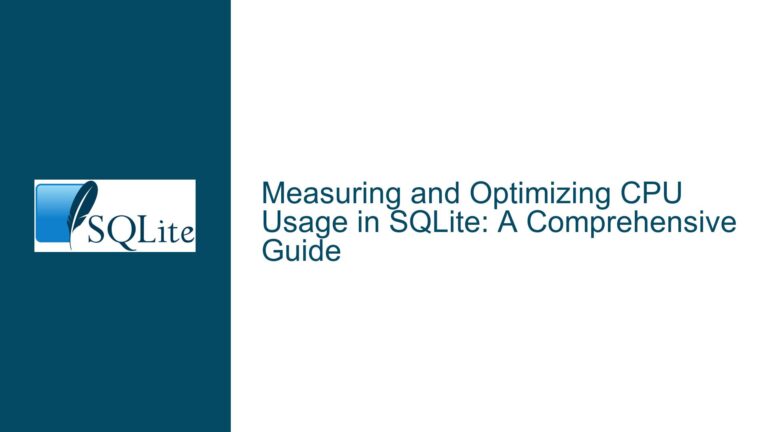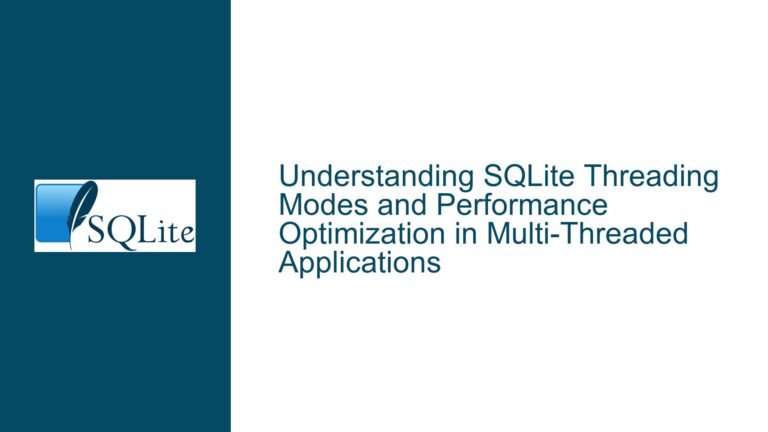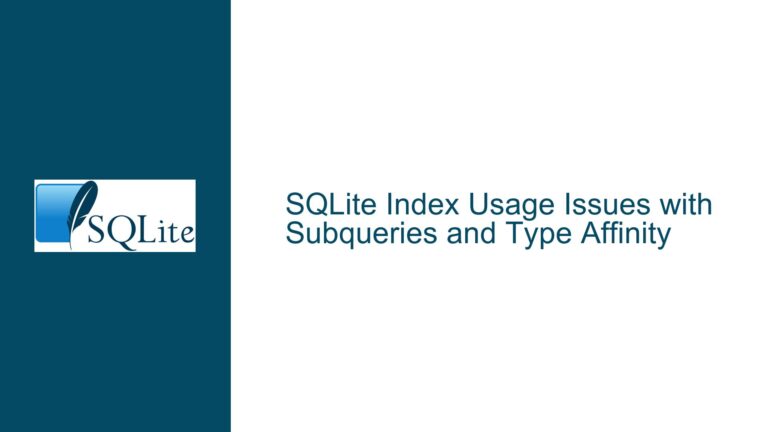Optimizing SQLite’s Default MMAP Limit for 64-bit Environments
Understanding SQLite’s Default MMAP Limit and Its Implications
SQLite’s memory-mapped I/O (MMAP) feature is a powerful mechanism that allows the database to map portions of its file directly into the process’s address space, bypassing the traditional file I/O operations. This can significantly improve performance for certain workloads by reducing the overhead associated with system calls and buffer management. However, the default configuration of SQLite’s MMAP feature, particularly the SQLITE_MAX_MMAP_SIZE limit, is optimized for 32-bit systems, where the address space is inherently limited. On 32-bit systems, the default limit of 2GB is appropriate, as it aligns with the constraints of the address space. However, in 64-bit environments, where the address space is vastly larger, this default limit can become a bottleneck, especially when dealing with multi-gigabyte databases.
The SQLITE_MAX_MMAP_SIZE limit is a compile-time setting that defines the maximum amount of memory that SQLite can use for memory-mapped I/O. This limit is not just a soft cap; it is a hard limit that cannot be exceeded, even if the system has ample memory available. For users who rely on precompiled SQLite libraries or language wrappers, changing this limit requires recompiling SQLite from source, which can be a non-trivial task. This limitation becomes particularly problematic in 64-bit environments, where the address space is large enough to accommodate much larger memory mappings, and where databases often exceed the 2GB limit.
The core issue here is that the default SQLITE_MAX_MMAP_SIZE limit is not well-suited for 64-bit environments. While 2GB might be a reasonable default for 32-bit systems, it is far too restrictive for 64-bit systems, where databases can easily grow to tens or hundreds of gigabytes. This mismatch between the default configuration and the capabilities of modern 64-bit systems can lead to suboptimal performance, as SQLite may not be able to fully leverage the benefits of memory-mapped I/O.
Exploring the Potential Downsides of Increasing the Default MMAP Limit
Before advocating for an increase in the default SQLITE_MAX_MMAP_SIZE limit for 64-bit environments, it is important to consider the potential downsides. One of the primary concerns is the impact on memory usage. Memory-mapped I/O allows SQLite to map portions of the database file directly into the process’s address space, which can lead to increased memory consumption. If the SQLITE_MAX_MMAP_SIZE limit is set too high, SQLite may consume a large amount of memory, potentially leading to memory pressure and reduced performance on systems with limited resources.
Another concern is the potential for increased fragmentation of the address space. In 64-bit environments, the address space is large, but it is not infinite. If SQLite is allowed to map large portions of the database file into memory, it could lead to fragmentation of the address space, making it more difficult for the operating system to allocate contiguous memory regions for other processes. This could potentially lead to reduced system performance, particularly on systems with many concurrent processes.
Additionally, increasing the default SQLITE_MAX_MMAP_SIZE limit could lead to compatibility issues with certain applications or environments. Some applications may rely on the default limit being 2GB, and increasing this limit could lead to unexpected behavior or performance issues. For example, an application that is designed to work with small databases might not be optimized to handle the increased memory usage that comes with a larger SQLITE_MAX_MMAP_SIZE limit.
Finally, there is the issue of portability. SQLite is designed to be a lightweight, portable database engine that can run on a wide variety of platforms and environments. Increasing the default SQLITE_MAX_MMAP_SIZE limit for 64-bit environments could make it more difficult to maintain this portability, as different platforms may have different constraints or limitations when it comes to memory-mapped I/O.
Strategies for Adjusting and Optimizing SQLite’s MMAP Configuration
Given the potential downsides of increasing the default SQLITE_MAX_MMAP_SIZE limit, it is important to carefully consider the best approach for adjusting and optimizing SQLite’s MMAP configuration in 64-bit environments. One possible solution is to provide a more flexible mechanism for configuring the SQLITE_MAX_MMAP_SIZE limit at runtime, rather than requiring it to be set at compile time. This would allow users to adjust the limit based on the specific requirements of their application and environment, without needing to recompile SQLite from source.
Another approach is to provide better guidance and documentation on how to configure SQLite’s MMAP feature for optimal performance in 64-bit environments. This could include recommendations for setting the SQLITE_MAX_MMAP_SIZE limit based on the size of the database and the available system resources, as well as best practices for monitoring and managing memory usage when using memory-mapped I/O.
For users who need to increase the SQLITE_MAX_MMAP_SIZE limit, one option is to recompile SQLite from source with a higher limit. This can be done by modifying the SQLITE_MAX_MMAP_SIZE define in the SQLite source code and then recompiling the library. However, this approach requires a certain level of technical expertise and may not be feasible for all users, particularly those who rely on precompiled libraries or language wrappers.
An alternative approach is to use the PRAGMA mmap_size statement to adjust the amount of memory that SQLite uses for memory-mapped I/O at runtime. This allows users to increase the amount of memory used for memory-mapped I/O without needing to recompile SQLite. However, it is important to note that the PRAGMA mmap_size statement is still subject to the SQLITE_MAX_MMAP_SIZE limit, so this approach may not be sufficient for users who need to use a very large amount of memory for memory-mapped I/O.
In addition to adjusting the SQLITE_MAX_MMAP_SIZE limit, users can also optimize the performance of SQLite’s MMAP feature by carefully managing the size and layout of their database files. For example, using a smaller page size can reduce the amount of memory required for memory-mapped I/O, while still allowing SQLite to efficiently access the database. Similarly, using a well-optimized schema and indexing strategy can help to reduce the amount of data that needs to be accessed via memory-mapped I/O, further improving performance.
Finally, it is important to monitor the performance and memory usage of SQLite when using memory-mapped I/O, particularly in 64-bit environments. This can be done using tools such as the SQLite command-line interface, which provides detailed information on memory usage and performance metrics. By carefully monitoring and adjusting the configuration of SQLite’s MMAP feature, users can ensure that they are getting the best possible performance from their database, while minimizing the risk of memory pressure or other issues.
In conclusion, while the default SQLITE_MAX_MMAP_SIZE limit of 2GB is appropriate for 32-bit systems, it is not well-suited for 64-bit environments, where databases can easily exceed this limit. Increasing the default limit for 64-bit systems could provide significant performance benefits, but it is important to carefully consider the potential downsides, including increased memory usage, address space fragmentation, and compatibility issues. By providing more flexible configuration options, better guidance and documentation, and tools for monitoring and optimizing performance, SQLite can better meet the needs of users in 64-bit environments, while maintaining its reputation as a lightweight, portable, and high-performance database engine.






